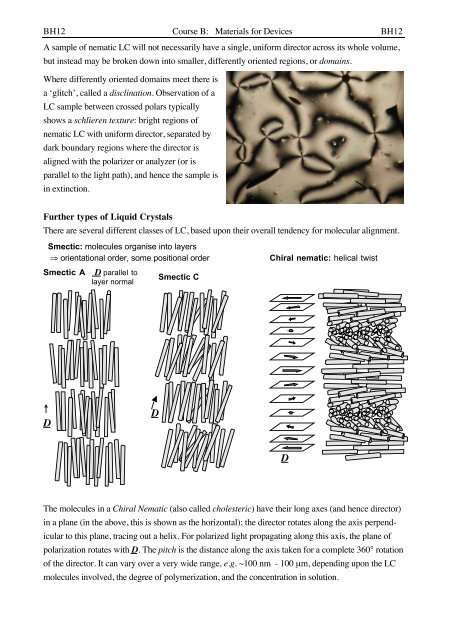Lecture handout including QS - Department of Materials Science ...
Lecture handout including QS - Department of Materials Science ...
Lecture handout including QS - Department of Materials Science ...
Create successful ePaper yourself
Turn your PDF publications into a flip-book with our unique Google optimized e-Paper software.
BH12 Course B: <strong>Materials</strong> for Devices BH12<br />
A sample <strong>of</strong> nematic LC will not necessarily have a single, uniform director across its whole volume,<br />
but instead may be broken down into smaller, differently oriented regions, or domains.<br />
Where differently oriented domains meet there is<br />
a ‘glitch’, called a disclination. Observation <strong>of</strong> a<br />
LC sample between crossed polars typically<br />
shows a schlieren texture: bright regions <strong>of</strong><br />
nematic LC with uniform director, separated by<br />
dark boundary regions where the director is<br />
aligned with the polarizer or analyzer (or is<br />
parallel to the light path), and hence the sample is<br />
in extinction.<br />
Further types <strong>of</strong> Liquid Crystals<br />
There are several different classes <strong>of</strong> LC, based upon their overall tendency for molecular alignment.<br />
Smectic: molecules organise into layers<br />
⇒ orientational order, some positional order<br />
Chiral nematic: helical twist<br />
Smectic A<br />
D parallel to<br />
layer normal<br />
Smectic C<br />
↑<br />
D<br />
D<br />
D<br />
The molecules in a Chiral Nematic (also called cholesteric) have their long axes (and hence director)<br />
in a plane (in the above, this is shown as the horizontal); the director rotates along the axis perpendicular<br />
to this plane, tracing out a helix. For polarized light propagating along this axis, the plane <strong>of</strong><br />
polarization rotates with D. The pitch is the distance along the axis taken for a complete 360° rotation<br />
<strong>of</strong> the director. It can vary over a very wide range, e.g. ~100 nm - 100 µm, depending upon the LC<br />
molecules involved, the degree <strong>of</strong> polymerization, and the concentration in solution.

















